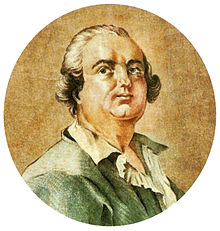Cagliostro in Vienna
| Work data | |
|---|---|
| Title: | Cagliostro in Vienna |
| Shape: | operetta |
| Original language: | German |
| Music: | Johann Strauss (son) |
| Libretto : | Camillo Walzel, Richard Genée and Gustav Quedenfeldt |
| Premiere: | February 27, 1875 |
| Place of premiere: | Vienna, Theater an der Wien |
| Place and time of the action: | Vienna around 1765 |
| people | |
|
|
Cagliostro in Vienna is an operetta in three acts by Johann Strauss (son) . The libretto comes from Camillo Walzel and Richard Genée , who also contributed to the musical development of the work. The work had its world premiere on February 27, 1875 in the Theater an der Wien in Vienna. This article deals with the 1941 revision by Gustav Quedenfeldt (text) and Karl Tutein (music).
action
first act
The Italian adventurer Cagliostro is on a secret mission in Vienna. At the behest of high-ranking French politicians, he is supposed to prevent the imminent engagement of the Austrian Archduke Leopold to the Spanish heiress Marie Luise. With the help of the street singer Lorenza, who belongs to him, Cagliostro succeeds in gaining the favor of the imperial moral commissioner Baron Sebastian Schnucki. It should serve as the key to an audience with Empress Maria Theresa. But Baron Schnucki is plagued by other worries: A few years ago he promised marriage to the middle-class woman Adami and she is now urging him to finally keep his promise. Frau Adami's niece Annemarie, on the other hand, would like to be led to the altar by Lieutenant Feri von Lieven, but the wealthy aunt does not provide the necessary money.
Second act
Cagliostro has managed to be admitted to Schönbrunn Palace. First he seeks the Infanta there. Thanks to his hypnotic powers, he influences her to write the empress a letter, according to which she renounces the engagement. The letter ends up in the hands of Baron Schnucki and Lieutenant Feri via a detour. The latter immediately suspects that Cagliostro is involved in the matter. However, the adventurer can evade arrest by going to the Empress and convincing her that he has found a means by which to turn any cheap metal into gold. With this, the black artist wrapped the gullible empress around her little finger. When Lieutenant Feri tries to enlighten her, she doesn't believe a word of him.
Third act
It doesn't take long, however, and Cagliostro sees his skins swim away. He learns from his friend Lorenza that his assistant Blasoni has given him notice. With him all secret documents had disappeared. The disappointed Blasoni passes this on to Lieutenant Feri, who can now prove that his suspicions were justified. Now it falls like scales from the eyes of the Empress. She promises the arrested adventurer freedom if he releases the infanta from her hypnosis. Cagliostro is understandably only too happy to do this. As soon as he has freed the princess from her spell, he leaves Vienna by the fastest route: with a balloon ready.
Little by little, the love problems of Mrs. Adami and her niece are also resolving. Maria Theresia ultimately calls on Baron Schnucki to keep his marriage vows. Reluctantly he wants to submit to the demand; but to his relief Mrs. Adami has found someone better: the pastry chef Teiglein, her niece's guardian. Her sudden love for this man also makes her more generous when it comes to money. She is now willing to provide the bail for Feri. At the end of the operetta there are two happy couples.
Notes, music
Strauss' Cagliostro suffered the opposite fate of his bat : While this failed at the premiere, but later brought him the greatest triumph, Cagliostro was initially a huge success, but later lost the favor of the audience. (The initial success is probably due not least to the fact that two of the roles were cast with audience favorites Marie Geistinger and Alexander Girardi .) In the long run, it was not to be overheard that the musical substance was less than that of the Bat, which was premiered the year before , and also the textbook had defects. Later, various arrangements were made to save the work for the stage. The one from 1941 by Karl Tutein and Gustav Quedenfeldt proved to be the most successful. As musical highlights are highlighted:

- Gypsy child, how shiny your hair is
- The rose blooms when the sun kisses it
- I could fly through life with you (Cagliostro waltz)
- High Austria (March)
- Please beautiful, please beautiful, o make us young, make us beautiful, we ask beautiful
Strauss used material from this operetta for some concert pieces:
- Cagliostro Quadrille , op.369 (1875)
- Cagliostro Waltz , op.370 (1875)
- High Austria! , op. 371 (1875)
- Here you go , op.372 (1875), Polka
- On the hunt , op.373 (1875), Schnellpolka
- Light and Shadow , op.374 (1875), Polka
Erich Korngold's arrangement of the operetta was premiered on April 13, 1927 in Vienna.
literature
- Anton Würz: Reclam's operetta guide . 23rd edition. Reclam, Stuttgart 2002, ISBN 3-15-010512-9 .
Web links
- Cagliostro in Vienna : Sheet music and audio files in the International Music Score Library Project
- More detailed table of contents
- March "Hoch Österreich!"